Research Article :
Cannon ML, Merchant M, Kabat W, Unruh B and Ramones A Objectives:
To determine the effectiveness of erythritol and xylitol in the inhibition of
gut bacteria possibly associated with Autism Spectrum Disorder (ASD) and Clostridium
difficile Infection (CDI). Methods:
Seven bacterial strains associated with ASD, or with CDI and a control
probiotic were tested for polyol inhibitory activity: Clostridium histolyticum, Bacteroides vulgatus, Bifidobacterium longham,
and two strains each of Clostridium
bolteae and difficile. Each strain was grown in
brain heart infusion/sucrose media with polyol concentrations varying from 0%
to 15% for erythritol and 0% -30 % for xylitol. Growth of Clostridium histolyticum and Bifidobacterium
longham was measured after 24 hours while all other strains were evaluated
at 48 hours to permit additional growth. Optical density was measured using a
spectrophotometer and the plates were read at 620 nm. Results:
All strains had results indicating polyol inhibition of growth. Clostridium histolyticum (Chis), Bifidobacterium longham (Blof), and both
Clostridium bolteae (Cbol) strains
showed reduced growth with increasing polyol concentration with an inflection
point of about 4% for both xylitol and erythritol (complete or near complete
inhibition relative to control wells). Bacteroides
vulgatus (Bvul) grew very lightly in the BHI/sucrose. This strain has
visible growth but very low OD values. Inhibition of growth with increasing
polyol concentrations was observed but assessing the polyol inhibition break
point was difficult with this strain. Conclusions: Xylitol and
erythritol at sufficient concentrations were able to inhibit the growth of
bacterial strains that have been associated with the development of Autism
Spectrum Disorder in recently published studies. Polyols have been used for decades as a substitute for
sucrose [1-4]. The most commonly used polyols for consumption are sorbitol,
mannitol, xylitol, erythritol, maltitol, lactitol and isomalt [5]. Besides
having fewer calories than regular sucrose, i.e., table sugar, polyols have
other reported health benefits, especially in regards to oral health [6]. Well
publicized studies showing the effectiveness of xylitol at reducing dental
disease have been reported for decades, all with results demonstrating safety
and effectiveness [7-9]. The well-publicized “Turku” and the “Belize” studies
reported on the caries reduction by xylitol, with xylitol being more effective
than sorbitol [10,11]. Xylitol chewing gums, toothpastes, lollipops, candies
and mouth rinses are all part of a complete dental oral hygiene program [12]. Erythritol
and xylitol are polyols that repeatedly have been demonstrated to possess
anti-cariogenic and anti-periodontal disease properties [13]. Polyols
(particularly the non-hexitol alditols or “sugar alcohols” erythritol and
xylitol) have been found effective in inhibiting the transition to and
maturation of biofilms from planktonic cells [14]. Xylitol clearly inhibits the
formation of mixed species biofilms, in vitro [15]. Erythritol suppresses the maturation of biofilms and
contributed to a healthier oral ecosystem [16]. Polyols can suppress the growth
and virulence expression of mixed bacterial biofilms. Erythritol was the most
effective polyol in suppressing the growth and organization of dental
pathogens. Erythritol also exerted inhibitory effects on several pathways reduced
growths through DNA and RNA depletion, attenuated extracellular matrix
production and alterations of dipeptide acquisition and amino acid metabolism
[17]. The bacteria associated with Autism Spectrum Disorder have
been reported in the literature, with similar results independent of research
institution and locality [18]. Autism Spectrum Disorder (ASD) has been linked
to propionic acid producing bacterial species, such as, Clostridia bolteae and Clostridia
histolyticum [19-22]. Conversely the presence of Clostridia sporogenes
could help protect against ASD by combining propionic acid with indole to
produce 3-Indole Propionate, a neural protective metabolite, thereby
neutralizing the epigenetic effect of propionic acid [23-25]. It has been
theorized that the absence of C.
sporogenes in the soil is related to the use of glyphosate, known by the
trade name Roundup [18]. Absence of C.
sporogenes in the soil and the environment could possibly shift the
maternal microbiome, resulting in epigenetic changes in the fetus or infant.
Bacteroides vulgatus also has been implicated in ASD as reported in the
Frontiers in Microbiology by Coretti et al. [26]. Clostridia difficile (Cdif) is a gram-positive bacterium
that is implicated in antibiotic-associated diarrhea. The relatively recent
emergence of a newer hyper-virulent North American strain (NAP1) has been
associated with the increase in incidence and severity of C. difficile infections (CDI) over the last decade [27]. Antibiotic
overuse remains the leading risk factor for C.
difficile infection. Several classes of antibiotics such as penicillins,
cephalosporins, fluoroquinolones, and clindamycin have been implicated in
causing CDI. Besides antibiotic usage, other risk factors are reported to
include advanced age, chemotherapy, use of proton pump inhibitors, chronic
renal disease, chronic liver disease and malnutrition [28,29]. Treatment
options include discontinuing the causative antibiotic and administering either
vancomycin or fidaxomicin. Another option is fecal transplantation, the process
in which feces from a healthy donor are transplanted into the intestinal tract
of a person with the disrupted microbial balance. This protocol has reported an
80% to 90% success rate in reducing the recurrence of C. difficile infections [30]. There remains some opposition to
Fecal Transplantation Therapy due to the basic nature of the procedure and
potential complications [31]. A simpler, safer and “cleaner” technique would be
more appealing to patients and clinicians. Assays were prepared in the anaerobic chamber. 96 well
plates were employed with each test preparation in triplicate wells by adding
100 mcL of BHI/Suc at 2x concentration to all test wells. Bacterial
preparations were made in BHI/Suc adjusted to a Macfarland standard
concentration of 0.5. Final assay inocula of each strain with a further 1:100
fold dilution. 100 mcL of bacterial inocula was added to each test well with or
without a polyol. Plates were incubated anaerobically for 24 or 48 hours and
terminated when bacterial growth reached a easily visible level in control
wells. Plate were then transferred to a plate spectrophotometer and read at 620
nm wavelength. Mean OD values for each well were calculated and OD values vs.
polyol concentration were plotted. Seven strains were tested for polyol inhibitory activity C. histolyticum, B. vulgatus, C. bolteae
(x2), C. difficile (x2), and Bifidobacterium longham. All strains
grew to variable bacterial density levels. B. vulgatus had the poorest growth
but still had measurable mean OD values to suggest polyol activity. Detailed OD
values vs. polyol concentration are plotted as follows with relative inhibition
inflection points (Figures 1-7). Figure 5: Both erythritol and xylitol inhibits B. vulgatis at only a 0.25% concentration. Erythritol inhibits ASD bacteria at a lower concentration
than xylitol. Both polyols were capable of significant inhibition of the ASD
associated bacteria, in addition to the inhibition of antibiotic resistant C. diff strains. Erythritol may inhibit Bacteroides vulgatus better than xylitol
but additional studies with a more optimal media for B. vulgatis need to be performed. However, Xylitol should be
considered as a treatment for C.
difficile infection due to its low cost and availability. In addition,
xylitol and erythritol are considered safe food additives with decades of use
in the prevention of oral diseases, such as periodontal disease and dental
cavities. Autism spectrum disorders are likely caused by a combination
of microbiome, environment, and the epigenetic interaction [32-34]. Recent
research shows that more than 50% of children with autism have GI symptoms,
food allergies, and maldigestion or malabsorption issues [35]. Propionic acid
is used as a food additive and is also a bacterial byproduct. Propionic acid
uptake may be related to lack of the bacterial gluten metabolizers and
resultant leaky gut. Elimination of calcium propionate as a bread
additive/preservative may be beneficial in reducing the behaviors associated
with ASD [36]. Shifting the oral and gut microbiome with polyols may also be
successful in reducing behaviors associated with ASD. More research, large
well-designed clinical trials are indicated for protocols illuminating
therapies effective with reducing the symptoms of ASD [37]. Xylitol and erythritol at sufficient concentrations were
able to inhibit the growth of bacterial strains that have been associated with
the development of ASD. Further research into the use of polyols for the
treatment and possible prevention of ASD is recommended. Large clinical trials
with patients that are correctly diagnosed with ASD then treated with xylitol
supplementation and the resultant effects on behavior should be carefully
explored. In addition, the uses of polyols to treat C. difficile infections also require clinical trials. *Corresponding author:
Citation:
Autism Spectrum Disorder, Polyol, Bacterial strains,
Optical density.Inhibition of Autism Spectrum Disorder Associated Bacteria and C. difficile by Polyols
Abstract
Full-Text
Introduction
Materials
and Methods
Bacterial isolates and media: C. bolteae
and C. histolytica strains were
kindly provided by Dr. Emma Allen- Verco PhD. (University of Guelph/Canada). B. vulgatis (8482) and B. longum (15707) were obtained from the
American Type Culture Collection (ATCCC/Manassas Va.). C. difficile strains 5555 and 5557 were provided by Dr. Larry
Kociolek MD (Lurie Children’s Hospital, Chicago, IL). All studies used a basal
media of Brain Heart Infusion broth supplemented with 2% sucrose (BHI/Suc).
Polyols were prepared separately at high concentrations in BHI/Suc for assay
plate preparations. Xylitol was added to 60% (w/v) and Erythritol was prepared
at 30% (w/v) in BHI/Suc. These polyol levels were the maximum achievable based
on solubility. Final media preparations were sterilized and placed in an
anaerobic chamber for at least 2 hours after preparation to cool and remain in
a reduced state.Assay
Procedures
Results
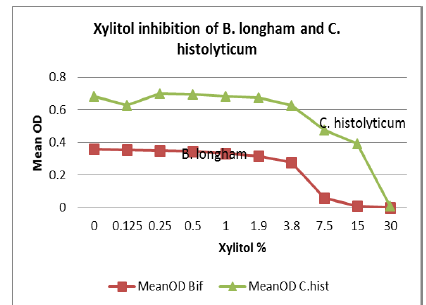
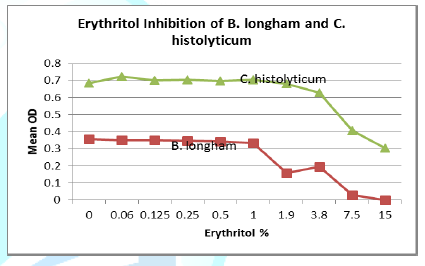
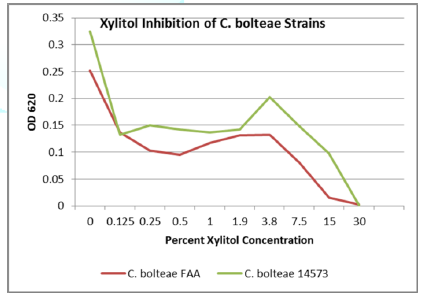
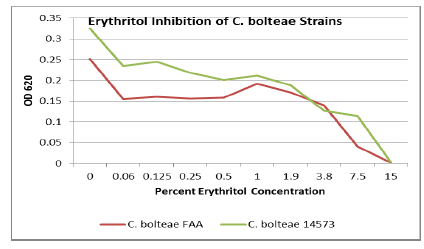
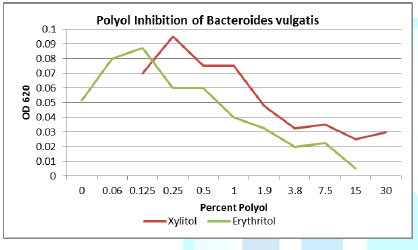
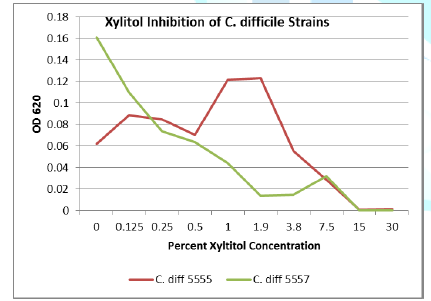
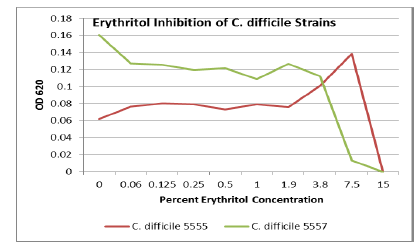
Discussion
Conclusion
References
Cannon ML, Ann
and Robert Lurie Children’s Hospital, Northwestern University,Feinberg School of Medicine, Chicago, USA,
E-mail:
drmarkcannon@outlook.com
Cannon
ML, Merchant M, Kabat W, Unruh B and Ramones A.
Inhibition
of autism spectrum disorder associated bacteria and c. difficile by polyols (2020) Edelweiss
Appli Sci Tech 4: 33-36. Keywords